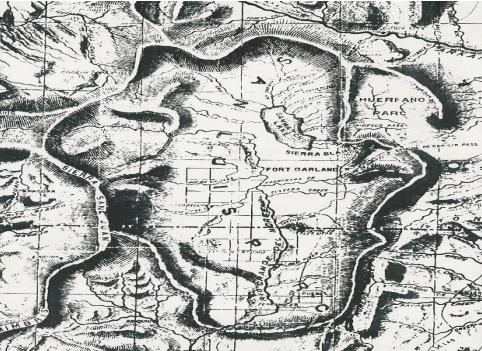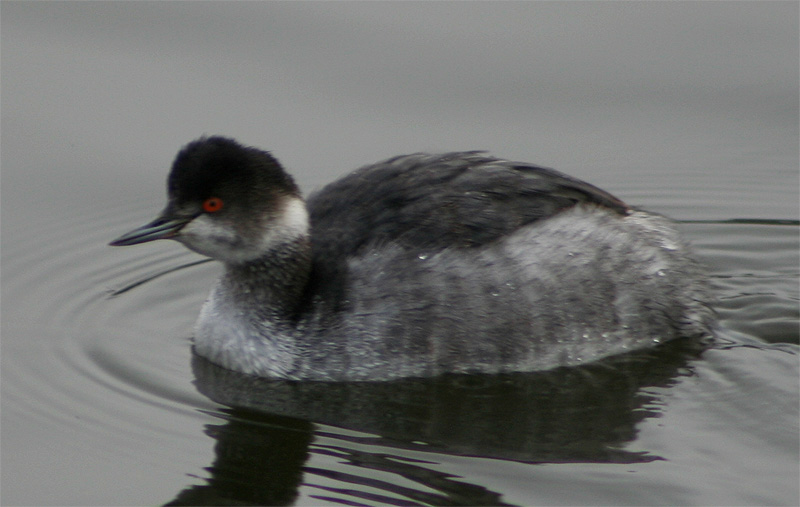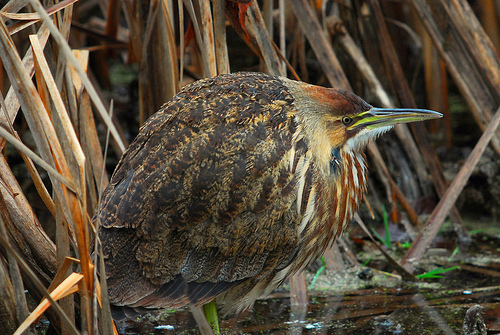|
Blanca Wildlife Habitat Area
The Blanca Wetlands Area of Critical Environmental Concern, or Blanca Wildlife Habitat Area, is an area of the San Luis Valley in Colorado, United States, that serves as a refuge for birds, fish and other wildlife. It is about northeast of Alamosa on County Road 25. The wetlands had been completely destroyed by pumping and diversion of water for irrigation. Starting in 1965 the Bureau of Land Management began to restore them, and they have become an increasingly important ecological habitat for shorebirds, waterbirds and other wildlife and native plants. Location The region has a cool, dry climate, with about 107 frost-free days each year. Temperatures range from to . Annual rainfall is about . The landscape is flat. Sand dunes carry sparse vegetation such as greasewood, rubber rabbit, salt grass, sandhill muhly and sand dropseed. The areas of dunes are intermingled with depressions and basins of historical playas. As late as the 1800s the area was wet, and the bones of ... [...More Info...] [...Related Items...] OR: [Wikipedia] [Google] [Baidu] |
San Luis Valley
The San Luis Valley is a region in south-central Colorado with a small portion overlapping into New Mexico. The valley is approximately long and wide, extending from the Continental Divide on the northwest rim into New Mexico on the south. It contains 6 counties and portions of 3 others. It is an extensive high-elevation depositional basin of approximately with an average elevation of above sea level. The valley is a section of the Rio Grande Rift and is drained to the south by the Rio Grande, which rises in the San Juan Mountains to the west of the valley and flows south into New Mexico. The San Luis Valley has a cold desert climate but has substantial water resources from the Rio Grande and groundwater. The San Luis Valley was ceded to the United States by Mexico following the Mexican–American War. Hispanic settlers began moving north and settling in the valley after the United States made a treaty with the Utes and established a fort in the early 1850s. Prior to ... [...More Info...] [...Related Items...] OR: [Wikipedia] [Google] [Baidu] |
Area Of Critical Environmental Concern
Areas of Critical Environmental Concern (ACEC) is a conservation ecology program in the Western United States, managed by the Bureau of Land Management (BLM). The ACEC program was conceived in the 1976 Federal Lands Policy and Management Act (FLPMA), which established the first conservation ecology mandate for the BLM. The FLPMA mandate directs the BLM to protect important riparian corridors, threatened and endangered species habitats, cultural and archeological resources, as well as unique scenic landscapes that the agency assesses as in need of special management attention. Criteria To be considered a potential ACEC an area must meet criteria of both relevance and importance. Relevance An area meets the relevance criteria of an ACEC if it contains one or more of the following: *A significant historic, cultural, or scenic value; *A fish or wildlife resource; *A natural process or system (including but not limited to areas supporting rare, endemic, relict, or endangered plant s ... [...More Info...] [...Related Items...] OR: [Wikipedia] [Google] [Baidu] |
Hen Harrier
The hen harrier (''Circus cyaneus'') is a bird of prey. It breeds in Eurasia. The term "hen harrier" refers to its former habit of preying on free-ranging fowl. It migrates to more southerly areas in winter. Eurasian birds move to southern Europe and southern temperate Asia. In the mildest regions, such as France and Great Britain, hen harriers may be present all year, but the higher ground is largely deserted in winter. The northern harrier was formerly considered to be a subspecies of the hen harrier. Taxonomy In 1758 the English naturalist George Edwards included an illustration and a description of the hen harrier in the first volume of his ''Gleanings of Natural History''. He used the English name "The blue hawk". Edwards based his hand-coloured etching on a bird that had been shot near London. When in 1766 the Swedish naturalist Carl Linnaeus updated his ''Systema Naturae'' for the twelfth edition, he placed the hen harrier with the falcons and eagles in the genus '' ... [...More Info...] [...Related Items...] OR: [Wikipedia] [Google] [Baidu] |
Greater Sandhill Crane
The sandhill crane (''Antigone canadensis'') is a species of large Crane (bird), crane of North America and extreme northeastern Siberia. The common name of this bird refers to habitat like that at the Platte River, on the edge of Nebraska's Sandhills (Nebraska), Sandhills on the American Great Plains. Sandhill Cranes are known to hangout at the edges of bodies of water especially in the Central Florida region. This is the most important stopover area for the Nominate subspecies, nominotypical subspecies, the lesser sandhill crane (''A. c. canadensis''), with up to 450,000 of these birds bird migration, migrating through annually. Taxonomy In 1750, English naturalist George Edwards (naturalist), George Edwards included an illustration and a description of the sandhill crane in the third volume of his ''A Natural History of Uncommon Birds''. He used the English name "The Brown and Ash-colour'd Crane". Edwards based his hand-coloured etching on a preserved specimen that had been b ... [...More Info...] [...Related Items...] OR: [Wikipedia] [Google] [Baidu] |
Forster's Tern
Forster's tern (''Sterna forsteri'') is a tern in the family Laridae. The genus name ''Sterna'' is derived from Old English "stearn", "tern", and ''forsteri'' commemorates the naturalist Johann Reinhold Forster. It breeds inland in North America and winters south to the Caribbean and northern Central America. This species is rare but annual in western Europe, and has wintered in Ireland and Great Britain on a number of occasions. No European tern winters so far north. This species breeds in colonies in marshes. It nests in a ground scrape and lays two or more eggs. Like all white terns, it is fiercely defensive of its nest and young. The Forster's tern feeds by plunge-diving for fish, but will also hawk for insects in its breeding marshes. It usually feeds from saline environments in winter, like most ''Sterna'' terns. It usually dives directly, and not from the "stepped-hover" favoured by the Arctic tern. The offering of fish by the male to the female is part of the courtship ... [...More Info...] [...Related Items...] OR: [Wikipedia] [Google] [Baidu] |
Eared Grebe
The black-necked grebe or eared grebe (''Podiceps nigricollis'') is a member of the grebe family of water birds. It was described in 1831 by Christian Ludwig Brehm. There are currently three accepted subspecies, including the nominate subspecies. Its breeding plumage features a distinctive ochre-coloured plumage which extends behind its eye and over its ear coverts. The rest of the upper parts, including the head, neck, and breast, are coloured black to blackish brown. The flanks are tawny rufous to maroon-chestnut, and the abdomen is white. When in its non-breeding plumage, this bird has greyish-black upper parts, including the top of the head and a vertical stripe on the back of the neck. The flanks are also greyish-black. The rest of the body is a white or whitish colour. The juvenile has more brown in its darker areas. The subspecies ''californicus'' can be distinguished from the nominate by the former's usually longer bill. The other subspecies, ''P. n. gurneyi'', can be di ... [...More Info...] [...Related Items...] OR: [Wikipedia] [Google] [Baidu] |
Common Yellowthroat
The common yellowthroat (''Geothlypis trichas'') is a New World warbler. In the U.S. Midwest, it is also known as the yellow bandit. It is an abundant breeder in North America, ranging from southern Canada to central Mexico. The genus name ''Geothlypis'' is from Ancient Greek ''geo'', "ground", and ''thlupis'', an unidentified small bird; ''thlypis'' is often used in the scientific names of New World warblers. The specific ''trichas'' is also from Greek; ' is a kind of thrush, the word being derived from ', "hair". Description Common yellowthroats are small songbirds that have olive backs, wings and tails, yellow throats and chests, and white bellies. Adult males have black face masks which stretch from the sides of the neck across the eyes and forehead, which are bordered above with white or gray. Females are similar in appearance, but have paler underparts and lack the black mask. Immature birds are similar in appearance to the adult female. First-year males have a faint black ... [...More Info...] [...Related Items...] OR: [Wikipedia] [Google] [Baidu] |
Avocet
The four species of avocets are a genus, ''Recurvirostra'', of waders in the same avian family as the stilts. The genus name comes from Latin , 'curved backwards' and , 'bill'. The common name is thought to derive from the Italian ( Ferrarese) word . Francis Willughby in 1678 noted it as the "Avosetta of the Italians". Biology Avocets have long legs and they sweep their long, thin, upcurved bills from side to side when feeding in the brackish or saline wetlands they prefer. Their plumage is pied, sometimes also with some red. Members of this genus have webbed feet and readily swim. Their diet consists of aquatic insects and other small creatures. They nest on the ground in loose colonies. In estuarine settings, they may feed on exposed bay muds or mudflats. The pied avocet is the emblem of the Royal Society for the Protection of Birds. Taxonomy The genus ''Recurvirostra'' was introduced in 1758 by Swedish naturalist Carl Linnaeus in the 10th edition of his to contain a sing ... [...More Info...] [...Related Items...] OR: [Wikipedia] [Google] [Baidu] |
American Bittern
The American bittern (''Botaurus lentiginosus'') is a species of wading bird in the heron family. It has a Nearctic distribution, breeding in Canada and the northern and central parts of the United States, and wintering in the U.S. Gulf Coast states, all of Florida into the Everglades, the Caribbean islands and parts of Central America. It is a well-camouflaged, solitary brown bird that unobtrusively inhabits marshes and the coarse vegetation at the edge of lakes and ponds. In the breeding season it is chiefly noticeable by the loud, booming call of the male. The nest is built just above the water, usually among bulrushes and cattails, where the female incubates the clutch of olive-colored eggs for about four weeks. The young leave the nest after two weeks and are fully fledged at six or seven weeks. The American bittern feeds mostly on fish but also eats other small vertebrates as well as crustaceans and insects. It is fairly common over its wide range, but its numbers are t ... [...More Info...] [...Related Items...] OR: [Wikipedia] [Google] [Baidu] |
White-faced Ibis
The white-faced ibis (''Plegadis chihi'') is a wading bird in the ibis family, Threskiornithidae. This species breeds colonially in marshes, usually nesting in bushes or low trees. Its breeding range extends from the western United States south through Mexico, as well as from southeastern Brazil and southeastern Bolivia south to central Argentina, and along the coast of central Chile. Its winter range extends from southern California and Louisiana south to include the rest of its breeding range. Description The white-faced ibis is very similar to the glossy ibis in its non-breeding plumages, but it tends to be slightly smaller and the plumage color is somewhat warmer. Breeding adults have a pink bare face bordered with white feathers (rather than a bluish bare face with no bordering feathers), a grey bill, and brighter colored, redder legs. Adults have red eyes year-round, whereas glossy ibises have dark eyes. Juveniles of the two species are nearly identical. Measurements: ... [...More Info...] [...Related Items...] OR: [Wikipedia] [Google] [Baidu] |
Snowy Plover
The snowy plover (''Charadrius nivosus'') is a small wader in the plover bird family, typically about 5-7" in length. It breeds in the southern and western United States, the Caribbean, Ecuador, Peru, and Chile. Long considered to be a subspecies of the Kentish plover, it is now known to be a distinct species. Parts of or entire beaches along the Central California coast are protected as nesting sites for the snowy plover and completely restricted to humans. UC Santa Barbara and the Vandenberg Space Force Base are two organizations leading the effort for beaches near them. Description Measurements: * Length: 5.9-6.7 in (15-17 cm) * Weight: 1.1-2.0 oz (32.5-58 g) * Wingspan: 13.4-17.0 in (34-43.2 cm) Taxonomy Genetic research published in 2009 strongly suggested that the snowy plover is a separate species from the Kentish plover, and by July, 2011, the International Ornithological Congress (IOC), and the American Ornithologists' Union (AOU) North American committee h ... [...More Info...] [...Related Items...] OR: [Wikipedia] [Google] [Baidu] |
Peregrine Falcon
The peregrine falcon (''Falco peregrinus''), also known as the peregrine, and historically as the duck hawk in North America, is a Cosmopolitan distribution, cosmopolitan bird of prey (Bird of prey, raptor) in the family (biology), family Falconidae. A large, Corvus (genus), crow-sized falcon, it has a blue-grey back, barred white underparts, and a black head. The peregrine is renowned for its speed, reaching over during its characteristic hunting stoop (high-speed dive), making it the fastest bird in the world, as well as the Fastest animals, fastest member of the animal kingdom. According to a ''National Geographic (U.S. TV channel), National Geographic'' TV program, the highest measured speed of a peregrine falcon is . As is typical for avivore, bird-eating raptors, peregrine falcons are Sexual dimorphism, sexually dimorphic, with females being considerably larger than males. The peregrine's breeding range includes land regions from the Arctic tundra to the tropics. It can b ... [...More Info...] [...Related Items...] OR: [Wikipedia] [Google] [Baidu] |






.jpg)

-4089.jpg)
.jpg)